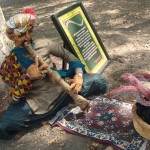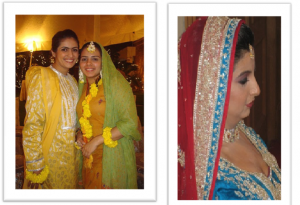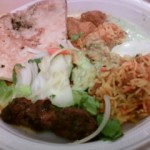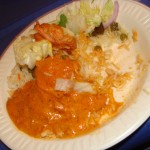MSA Dinners, Snake Charmers, and Festivals
-Hira Ismail, BMC ’13
I went to two Muslim Student Association Dinners, one sponsored by Bryn Mawr and Haverford’s MSA at Founders Hall, and one sponsored by Drexel University’s MSA. The first dinner was in celebration of Eid-ul-Fitr, the Muslim holiday in celebration of the completion of the Holy Month of Ramadan, a month of fasting. We had spoken-word poetry and dinner. The second dinner was a welcome-back dinner for Drexel’s MSA, and there was a speaker who discussed MSA’s goals for the year. At both, South Asian food was served, so I snapped a photo of each. 🙂 The pictures of the snake charmer display and the festival tents were taken at a Hari Krishna Festival in Philadelphia. I was participating in College Day on the Parkway, and after exploring the museum, I spotted this festival, and went to check it out. There were various booths set up. Some had information about the Geeta, and summarized some of the core beliefs and stories about Krishna. Some had information about reincarnation and the theories behind that. Some stalls were set up where food, clothing, and books on yoga/meditation were being sold. There was a religious chant playing the entire time on loudspeakers. It was overall a very colorful festival that I luckily stumbled upon.

~ * ~
What Has It Come To?
-Anita Kilambi, BMC ’13
A common stereotype is attached to the South Asian subcontinent: music and dance are nothing but loaded Punjabi music and Bollywood “hungama.” The truth of the matter is that Bollywood is only a contemporary adaptation of the arts of South Asia. South Asian dance forms originate from the early medieval ages. They range from styles of Kathak, Bharatanatyam, Kuchipudi, Kathkali, Kandyan, and many more. Most of these dances were used to symbolize religion, stories, self defense, and much more. But nowadays, the steps and grace of these dances are being taken and butchered into meaningless entertainment. Bollywood dancing is a commercialized form of various classical dances with different colors and loud percussion instruments added on; thus, the beauty and originality of the dance has been lost. Many choreographers are trained in South Asian dance forms, but have to succumb to stereotypes that are continuously being encouraged by the Bollywood film industry. With the passing years, the dances in Bollywood movies have been changing, from classical dancing to raunchy hip hop “posery”. My question is: where is the grace and beauty from the classics?
Actors and actresses are forced to revert to what the assumed favorite style is, “filmi dance”, but have any the directors given any thought on how they are portraying South Asia? How do South Asians feel about the demise of the South Asian name to be only about colorful movie dances and loud percussion instruments? As a South Asian brought up in America, I have come to understand that colors and loud music are a part of South Asian arts, but are they truly the defining representations for what South Asian arts look like? For example, lets take Kandyan Dance, also known as Kandy. This dance originates from Sri Lanka and is known for its distinguished whirling movements and intricate somersaults. Saroj Khan is a noted Kandyan Dancer who is a choreographer to the Bollywood industry. My question is why are we not seeing more Kandyan Dancing? We have a notable teacher, why isn’t Aishwariya Rai Bachan or Deepika Padukone dancing in this form? Once again, we are back to the same conclusion: from the lack of knowledge and the lack of taking responsibility to spread that knowledge has lead to bright colors, finger pointing, and repetitive percussion music.
Source: http://www.southasiandance.org.uk/danceguide.php
~ * ~
The Glory of Pakistani Weddings
-Fiza Mohammad, BMC ’14
Culturally, weddings in Pakistan bring together family and friends to share the happiness with the bride and groom. Families begin preparation months before, ordering mithai (sweets), clothes, furniture for dowry and various other things. Typically weddings last a week beginning with a sermon of the Holy Quran and a prayer (milad) and ending with a grand reception (valima).





